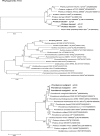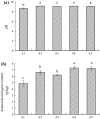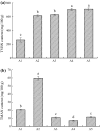Isolation and identification of hyper-ammonia-producing bacteria from commercial fermented skates (Raja kenojei)
- PMID: 30483004
- PMCID: PMC6233455
- DOI: 10.1007/s13197-018-3447-9
Isolation and identification of hyper-ammonia-producing bacteria from commercial fermented skates (Raja kenojei)
Abstract
Ammonia-producing bacteria were isolated and identified from five commercial fermented skates (A1, A2, A3, A4, and A5). In addition, the pH, ammonia nitrogen, total volatile nitrogen (TVBN), trimethylamine nitrogen (TMAN), and amino nitrogen contents of skate samples were also determined. A total of 88 strains of ammonia-producing bacteria was isolated and seven hyper-ammonia-producing bacteria isolates (A2-2, A2-3, A2-12, A2-18, A2-20, A3-6 and A3-14) were selected based on ammonia nitrogen producing ability. Those isolates were identified as Proteus hauseri (three strains), Providencia rustigianii (three strains), and Kurthia gibsonii. The pH and ammonia nitrogen content in skate samples were ranged from 8.63 to 9.03, and 4.86 to 7.31 g/kg, respectively. No significant difference of pH values was observed in skate samples A2, A3, A4 and A5. While, skate samples A3, A4 and A5 showed similar level of TVBN and TMAN content. Skate sample A2 showed the highest amino nitrogen content among all samples, which indicated the highest degree of protein degradation of skate muscle during fermentation. Bivariate cluster analysis showed that skate samples A3, A4, and A5 clustered together at a relatively high level, implying a similar microbial environment during fermentation. The cluster analysis allowed different commercial fermented skates to be clearly differentiated based on the characteristics determined in this study. This study can provide important information for investigating the mechanisms underlying ammonia flavor formation in skate muscle during fermentation.
Keywords: Ammonia producing bacteria; Cluster analysis; Fermented skate; Identification; Isolation.
Conflict of interest statement
Compliance with ethical standardsThe authors declare that they have no conflict of interest.
Figures





Similar articles
-
Prokaryotic community composition in alkaline-fermented skate (Raja pulchra).Food Microbiol. 2017 Feb;61:72-82. doi: 10.1016/j.fm.2016.08.008. Epub 2016 Aug 31. Food Microbiol. 2017. PMID: 27697172
-
Protein degradation and texture properties of skate (Raja kenojei) muscle during fermentation.J Food Sci Technol. 2022 Dec;59(12):4713-4722. doi: 10.1007/s13197-022-05553-7. Epub 2022 Aug 6. J Food Sci Technol. 2022. PMID: 36276531 Free PMC article.
-
Shotgun metagenomics approach reveals the bacterial community and metabolic pathways in commercial hongeo product, a traditional Korean fermented skate product.Food Res Int. 2020 May;131:109030. doi: 10.1016/j.foodres.2020.109030. Epub 2020 Jan 24. Food Res Int. 2020. PMID: 32247457
-
A net carbohydrate and protein system for evaluating cattle diets: I. Ruminal fermentation.J Anim Sci. 1992 Nov;70(11):3551-61. doi: 10.2527/1992.70113551x. J Anim Sci. 1992. PMID: 1459918 Review.
-
Upflow anaerobic sludge blanket reactor--a review.Indian J Environ Health. 2001 Apr;43(2):1-82. Indian J Environ Health. 2001. PMID: 12397675 Review.
Cited by
-
Bacteriological Quality and Biotoxin Profile of Ready-to-Eat Foods Vended in Lagos, Nigeria.Foods. 2023 Mar 13;12(6):1224. doi: 10.3390/foods12061224. Foods. 2023. PMID: 36981151 Free PMC article.
-
Real-Time Tunable Gas Sensing Platform Based on SnO2 Nanoparticles Activated by Blue Micro-Light-Emitting Diodes.Nanomicro Lett. 2024 Aug 8;16(1):261. doi: 10.1007/s40820-024-01486-2. Nanomicro Lett. 2024. PMID: 39112731 Free PMC article.
References
-
- Carslaw DC, Beevers SD. Characterising and understanding emission sources using bivariate polar plots and k-means clustering. Environ Model Softw. 2013;40:325–329. doi: 10.1016/j.envsoft.2012.09.005. - DOI
-
- Chen Z, Zhang WJ, Wang DS, Ma T, Bai RY. Enhancement of activated sludge dewatering performance by combined composite enzymatic lysis and chemical re-flocculation with inorganic coagulants: kinetics of enzymatic reaction and re-flocculation morphology. Water Res. 2015;83(15):367–376. doi: 10.1016/j.watres.2015.06.026. - DOI - PubMed
LinkOut - more resources
Full Text Sources
